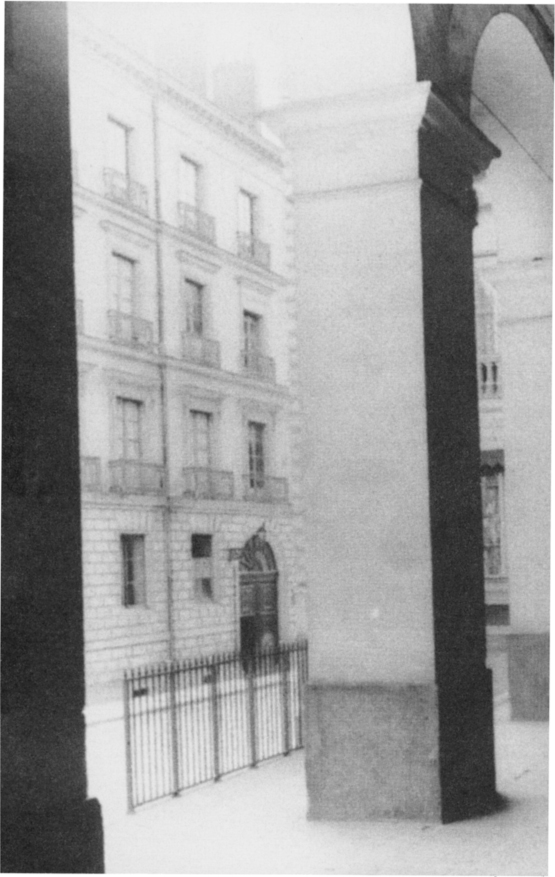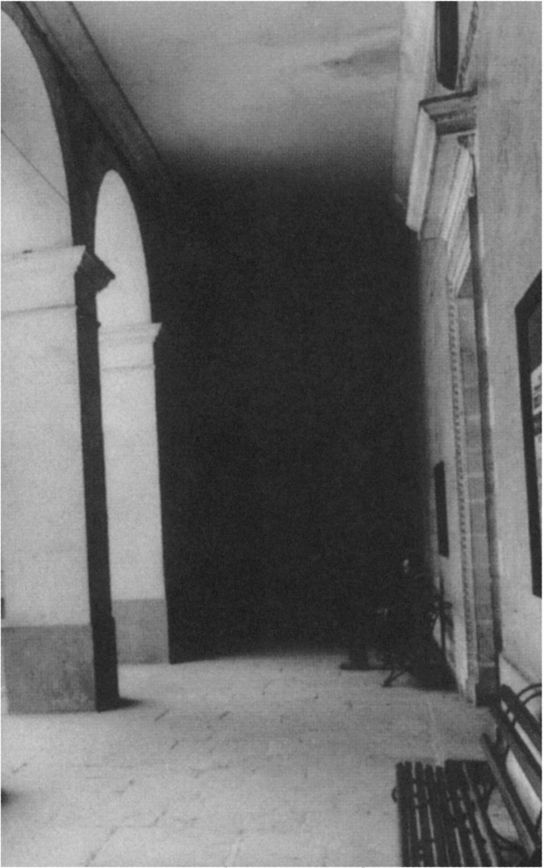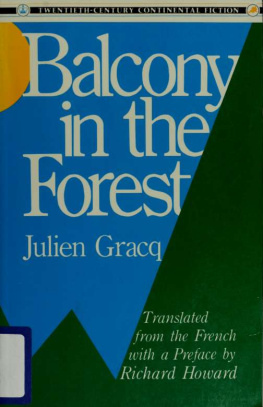Julien Gracq - The Shape of a City
Here you can read online Julien Gracq - The Shape of a City full text of the book (entire story) in english for free. Download pdf and epub, get meaning, cover and reviews about this ebook. year: 2020, publisher: Turtle Point Press, genre: Science. Description of the work, (preface) as well as reviews are available. Best literature library LitArk.com created for fans of good reading and offers a wide selection of genres:
Romance novel
Science fiction
Adventure
Detective
Science
History
Home and family
Prose
Art
Politics
Computer
Non-fiction
Religion
Business
Children
Humor
Choose a favorite category and find really read worthwhile books. Enjoy immersion in the world of imagination, feel the emotions of the characters or learn something new for yourself, make an fascinating discovery.
- Book:The Shape of a City
- Author:
- Publisher:Turtle Point Press
- Genre:
- Year:2020
- Rating:5 / 5
- Favourites:Add to favourites
- Your mark:
- 100
- 1
- 2
- 3
- 4
- 5
The Shape of a City: summary, description and annotation
We offer to read an annotation, description, summary or preface (depends on what the author of the book "The Shape of a City" wrote himself). If you haven't found the necessary information about the book — write in the comments, we will try to find it.
The Shape of a City — read online for free the complete book (whole text) full work
Below is the text of the book, divided by pages. System saving the place of the last page read, allows you to conveniently read the book "The Shape of a City" online for free, without having to search again every time where you left off. Put a bookmark, and you can go to the page where you finished reading at any time.
Font size:
Interval:
Bookmark:



Julien Gracq
TRANSLATED BY INGEBORG M. KOHN
TURTLE POINT PRESS NEW YORK
FIRST PUBLISHED IN FRENCH IN 1985
BY DITIONS CORTI
ENGLISH TRANSLATION COPYRIGHT 2005
BY INGEBORG M. KOHN
PAPERBACK ISBN 978-1-885586-39-1
EBOOK ISBN 978-1-885983-92-3
LCCN 2004113838
DESIGN AND COMPOSITION BY JEFF CLARK AT
WILSTED & TAYLOR PUBLISHING SERVICES

as we all know, changes more rapidly than the heart of a mortal. However, it often happens that before being discarded, left behind to become the prey of its memories, the citycaught, like all other cities, in the vertiginous metamorphosis that characterizes the second half of our centurywill have found ways to change a heart still young and impressionable just by subjecting it to its climate and landscape, and by leaving an imprint of its streets, boulevards, and parks on the most private thoughts and daydreams of its owner. It is not necessary to have lived there like an ordinary citizen; I even doubt that it would make much of a difference. The citys influence will be much stronger, and perhaps last longer, if it has remained partially hiddenif, because of some unusual circumstances, we have lived in its midst but never reached a degree of familiarity, much less of intimacy, if we never had the freedom, nor enough leisure time to walk through its neighborhoods aimlessly, to stroll its streets at will. It is possible that by making only certain concessions and without ever completely surrendering, the city hasjust like a womantightened the threads spun by our daydreams around herself, and better adapted the rise and development of our desires to her rhythms and moods.
To live in a city means weaving ones daily peregrinations into a maze of paths usually linked around several directional axes. If one disregards all movements connected with ones job and counts only those steps leading from the center to the periphery and back again, it becomes clear that Ariadnes thread, which ideally unravels behind the true city dweller, takes on the characteristics of a carelessly wound skein of wool. It encloses an entire complex of streets and squares within a finely meshed network of comings and goings; seldom do we wander into outlying areas, venture forth beyond the familiar haunts. There is not the slightest similarity between the plan of a city and our mental image of it as we consult the unfolded map, or between the sediment deposited in memory by our daily wanderings and the sound of its name. The Paris where I lived while a student, and later on during my mature years, is contained in a rectangle bordered in the north by the Seine, and almost entirely by the boulevard Montparnasse along the south. This heart of an area which comes alive during my daily peregrinations is surrounded by concentric circles whereat least in my perceptionall activity progressively decreases until, close to the periphery, they become lifeless, indistinguishable from each other. It is the central chambers of a labyrinth that attract the city dweller like a magnet, a locale he returns to time after time; its perimeter serves mostly as a protective screen, an insulating layer intended to shield the inhabited cocoon, and to prevent any osmosis between the outlying areas and the true city life securely locked within that inner sanctum.
This is not how I lived in Nantes. The regime of the boarding school, during the nineteen-twenties, was strict. We were forbidden to leave the premises except for vacations, and on Sundays; furthermore, it was required that a designated person come to collect us in the parlor, and also deliver us there in the evening. I left the school only once every fortnight; the rest of the time, all I could see of the city were the crowns of the magnolia trees in the Botanical Gardens beyond the walled-in courtyard and, whenever the gates were opened to let in the day students, at five minutes before eight in the morning, and at five minutes before two in the afternoon, a brief glimpse of the museums faade. But this strict reclusion was like a one-way street. Twice a day, like the tide, the sounds of Nantes poured in together with the wave of day students, sometimes just filtering through, sometimes in a loud blast. I lived in the heart of a city that loomed large in my imagination, but which I did not know very well. I was aware of certain landmarks, and familiar with some itineraries, but its substance, and even its smells, never lost their exotic flavor; a city where all the views led only to ill-defined, unexplored, faraway vistas, a loose framework easily absorbed into fiction. Each of the rhumbs of this compass shone brightly but separately in my imagination, like lone stars not part of any constellation.
I was eleven years old, and just starting sixth grade. Half-known, half-imagined in my dreams, the city has never cast off that impression Ive kept since our first contact. Later on, I lived an entire year in Nantes under ordinary circumstances, in order to complete my military service as a second lieutenant, and then returned again to teach in the same lyce I had attended as a student. How odd that not a single distinct memory has survived to remind me of the new familiarity gained during that time, which evaporated as soon as it was interrupted. Today, I would get lost in the streets of the neighborhood where I lived during that year, I could not even recognize the house where I lived; it seems as if the time I lived in Nantes like anyone else never existed. Something that at first haunts you with all the charms of a faraway, unattainable princess will evaporate later on during the disenchantment of cohabitation.
A city which remains for such a long time almost off limits eventually becomes the very symbol of freedom. Every time I am back wandering through Nantes, the brisk breeze still blowing through its streets refreshes them pleasantly and for me alone: the city, anchored in solid ground that supports it securely on both sides of its strangled estuary, is already subject to an inland, rather than seaside, climate, quite different from that of Quimper, where I lived later on, whose coastal sky changes with the tidal flow. It is only in La Fosse, a residential area located almost on the outskirts of Nantes, that one senses the presence of the sea; here is where the riverbed suddenly deepens into a channel, signaling the end of a stream which up to this point flowed leisurely through the countryside, holding its own against encroaching green meadows, and which, in my youth, still lingered around the islands of Nantes just like a varenne tourangelle (one of those plains near Tours inundated periodically by the Loire). It was not the sea breeze that aerated the streets, but that mental lightheartedness which takes hold of us at every intersection where, in our imagination, the unpredictable lies in ambush. At the end of childhood, at the end of adolescence, powerful images infiltrate the mind, goals deemed attainable beckon and vie for our attention so vehemently they trigger dizzy spells, leaving us overwhelmed by the enormity of what is left unaccomplished at the end of each day, by the prospect of so many
Font size:
Interval:
Bookmark:
Similar books «The Shape of a City»
Look at similar books to The Shape of a City. We have selected literature similar in name and meaning in the hope of providing readers with more options to find new, interesting, not yet read works.
Discussion, reviews of the book The Shape of a City and just readers' own opinions. Leave your comments, write what you think about the work, its meaning or the main characters. Specify what exactly you liked and what you didn't like, and why you think so.













